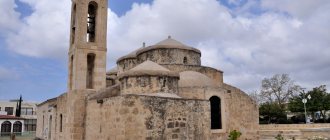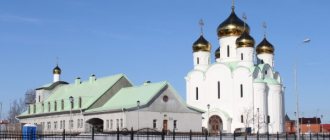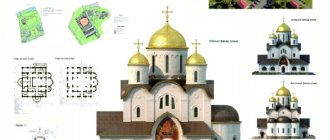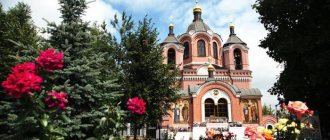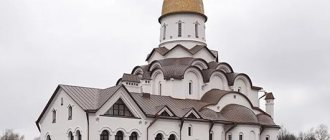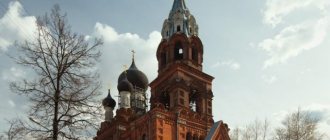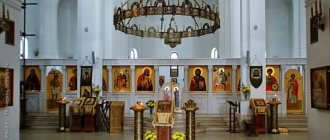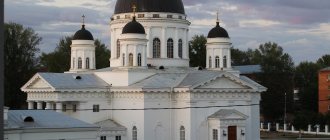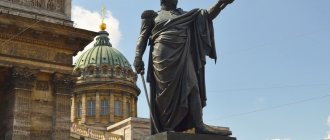"Save me, God!".
Thank you for visiting our website, before you start studying the information, please subscribe to our Orthodox community on Instagram, Lord, Save and Preserve † - https://www.instagram.com/spasi.gospodi/. The community has more than 60,000 subscribers. There are many of us like-minded people and we are growing quickly, we post prayers, sayings of saints, prayer requests, and timely post useful information about holidays and Orthodox events... Subscribe. Guardian Angel to you!
In Orthodoxy there are many churches where people come to pray, ask for help, and confess their sins and actions. It is there that people can ease their souls and find understanding. The largest number of different churches and monasteries are located in large cities. This is explained by many residents. Therefore, it is not surprising that Moscow is famous for its many churches. Among them, the Temple of Paraskeva Friday in Butovo is worthy of attention. This saint is considered one of the most revered in Orthodoxy. Therefore, it is not surprising that many church monasteries bear her name.
Holy Great Martyr Paraskeva
Paraskeva Pyatnitsa is considered the patroness of agricultural workers.
Industrialists, traders and travelers also consider themselves to be under her tutelage and care. In pre-revolutionary Russia there was not a single shopping area where the Church of St. Paraskeva Pyatnitsa did not stand; in Moscow alone there were 4 of them. The name Pyatnitsa was given to her by her parents in memory of the day of the crucifixion of Christ. Paraskeva translated from ancient Greek means “eve of the holiday.” In the Orthodox Church, the day of remembrance of this great martyr falls on October 28. On this day, it is customary to bring fruits to the altar for consecration and store them until the next harvest, thus ensuring its subsequent abundance. They pray to this saint both for the harvest and to prevent the death of livestock. In people, it can heal serious illnesses - both mental and physical. In addition, centuries-old experience contributed to the formation of the tradition of asking girls from the saint for help in a speedy and successful marriage. Therefore, every temple of the Great Martyr Paraskeva Friday is popular. On icons the saint is always depicted with a cross in her hands and a red maforia. She is always strict and stern, and in the paintings associated with the Passion of Christ, she represents Good Friday, the day of Christ's crucifixion. Among the Orthodox, her image is intertwined with Mokosha, a pagan deity, also the patroness of fields and livestock, to whom Friday was also dedicated.
Patronal holidays
There are two altars in the temple. The main one was consecrated in honor of St. Martyr Paraskeva Pyatnitsa, whose memory is celebrated by the Orthodox Church on October 27. The second is in honor of the Nativity of the Virgin Mary, the memory is honored on September 21, as the logical beginning of the new Orthodox year.
Divine service in the Church of the Holy Great Martyr Paraskeva Pyatnitsa
Divine services are held in the temple every day. On weekdays it starts at 8 a.m. in the morning and at 5 p.m. in the evening. On Sundays and the Twelfth Feast, the evening service is also celebrated from 17.00, and there are two liturgies: at 7.00 and 10.00.
The emergence of Butovo
The Temple of Paraskeva Pyatnitsa in Butovo is one of many religious sites dedicated to this great martyr in Moscow. The church has a rich history that began three hundred years before the emergence of the huge Northern Butovo region. Since the 17th century, the concept of “village” has existed in Russia, which is a very small settlement, literally several courtyards in size. But it had to include a chapel. Butovo, owned by clerk Samoilov, was such a village with five households - 3 peasant and 2 bobyl, that is, not having any land plots. It arose on the site of a village of landowners, the Shcherbatovs, who had owned these lands since the 15th century, which burned to the ground.
How to get there
The address of this temple: Moscow, Starokachalovskaya street 8, building 1. The temple is open every day from 07 am to 20.00 pm. You can get there by metro. You need to get off at the Dmitry Donskoy Boulevard station. You will have to walk a little, but then an incredibly beautiful sight will open before you. Both the external and internal beauty of this structure will make you stop and admire it.
The best article for you, go to: Temple of Boris and Gleb in Degunino
The Lord is always with you!
Chapel, church, temple
There was a wooden church on their estate, which also burned down during the Polish-Lithuanian invasion in 1612. Decades later, namely in 1694, a new stone church was consecrated here, built in the new Russian style according to the design of the architect Blagoveshchensky. The Temple of Paraskeva Pyatnitsa in Butovo was small, and in the 18th century a chapel of the Nativity of the Virgin Mary was added to it. Now there could be up to 400 believers here. In 1903-1904 the temple was renovated. Nearby, in the village of Znamenskoye Sadki, the estate of the Trubetskoy princes, there was also a church, but it has not survived. Together, these two religious buildings were either united into one parish, or separated.
The Paraskeva Pyatnitsa Church in Butovo received its name from a roadside chapel, many of which were named after this saint from ancient times, and she was popular in Rus' even in pre-Mongol times. How could it be otherwise - after all, she patronized the traveler and merchant! Her icon in a glass icon case, a kind of chapel, is now located on the outside of the temple. The church is very beautiful. It, along with the temples dedicated to this saint, erected in ancient Chernigov and Smolensk and preserved to this day, are architectural monuments. The grave of the last rector, Nikolai Bogoyavlensky, is located near the altar, on the east side.
Temple shrines
Like other temples, there are also shrines here:
- Icon "Quick to Hear"
- Icon of the Mother of God “Helper of Sinners”,
- icon "The Sign",
- "Sovereign" icon
- icon “Unexpected joy”,
- "Inexhaustible Joy"
- "Healer"
- Icon "Vilna-Ostrobramskaya".
The best article for you, go to: Church of All Saints in Krasnoe Selo
In addition, there are also reliquaries. The temple has a main altar, which was consecrated in honor of Paraskeva Friday. There is a chapel in honor of the Nativity of the Blessed Virgin Mary. The side throne bears the name of Dmitry Donskoy.
Years of hard times
The Church of Paraskeva Pyatnitsa in Butovo suffered all the hardships of the 30s, when churches and their ministers were destroyed. It was closed, desecrated and looted. Then for many years it housed either warehouses or sewing workshops, and later the temple completely burned down. Destroyed, without windows, doors and roof, it began to be restored in the 90s by the efforts of the community to which it was transferred, and in 1998 the temple was consecrated by the Patriarch of Moscow. Believers brought icons, and new ones were ordered from donations. When there was no huge residential microdistrict of Severnoe Butovo, there were several villages in this place - Kiovo, Bitsa, Kachalovo. Therefore, the Church of Friday in Butovo has another name, so to speak, a synonym - the Temple of Paraskeva Friday in Kachalovo.
It is very popular among the local population, but small. Therefore, the construction of a new large religious building, named in honor of the Prophet Elijah, is planned in this area.
Moscow.org Moscow city portal
| All photos |
The most famous church in Moscow in honor of St. The Great Martyr Paraskeva Pyatnitsa stood until 1928 in Okhotny Ryad - where the State Duma building is now located. Saint Paraskeva Friday (translated from Greek “Friday” means eve, the threshold of the holiday) is considered the patroness of fields, livestock, possibly trade, as well as a healer of people from physical and mental illnesses.
The first Paraskeva Pyatnitsa Church was built in Moscow before 1406. There were ancient documents in which it was mentioned as a church among the “old genders”. In the distant past, this was the name given to small venues where judicial duels were held. For a long time it was believed that they took place exclusively on the territory of the Kremlin, but a document found indicated that this was not the case. The history of this method of resolving controversial issues dates back to the 13th century. Then the presence of a plaintiff, defendant, witnesses and evidence was considered insufficient to reach a verdict. It was not customary to take an oath for fear of harming the soul in case of false testimony. Thus, the decision of the matter was left to the “Will of God”, and simply, whoever turned out to be stronger in the duel was right. Unlike Europe, where such trials were especially cruel, in Russia they fought with clubs - stupid ones, and they happened only in the most exceptional cases. The loser was found guilty and paid legal costs. It is interesting that any free resident could be summoned to such a trial, regardless of rank and wealth. If one of the parties were women or old people, they delegated a “combatant” who defended their interests. Such fights were canceled in 1556, during the reign of Ivan the Terrible.
In the 17th century, on the site of the ancient wooden Pyatnitskaya Church in Okhotny Ryad, Prince Vasily Golitsyn built a new beautiful two-story church. The first floor of the temple was consecrated in honor of Paraskeva Pyatnitsa, and on the second floor the Resurrection Church was built, consecrated in 1687 by Patriarch Joachim. The Church of the Resurrection became the Golitsyns’ home church, and a long passage was built from it to the prince’s chambers. One of the richest and most educated people of his era, Prince Golitsyn fell into disgrace after the suppression of the Streletsky rebellion, and was deprived of property, as well as a house with a church (Peter I donated them to the Georgian princes).
When in 1755 in the building of the Main Pharmacy (former Zemsky Prikaz). Located on Red Square, Moscow University began its work; it did not have its own home church. The service in honor of its opening, as well as subsequent ones, was initially held in the Kazan Cathedral. But the search for a suitable church began almost immediately after the opening of the university, and the choice fell on the Church of Paraskeva Pyatnitsa in Okhotny Ryad, because it was located near the university building. But, as already mentioned, by this time the church had passed into the possession of Princess Anna of Gruzinskaya, a relative of the Georgian king Archil. The princess refused the offer to transfer the family inheritance, leaving the church behind her.
In 1737, a fierce fire that destroyed most of Moscow did not spare the Pyatnitskaya Church in Okhotny Ryad. The temple was restored, but despite this, in 1775 they decided to demolish it in order to build a square on this site.
The intercession of Metropolitan Plato saved the church, and the temple continued to operate. After the victorious end of the Patriotic War of 1812, at the expense of the noble assembly, two new chapels were built in the upper part of the Pyatnitskaya Church: St. Alexander Nevsky and the martyr Catherine (in honor of the emperor and his sister). In the lower Pyatnitskaya Church, two chapels were also consecrated: in the name of St. Nicholas the Wonderworker and John the Warrior, and on the church bell tower there was an ancient bell from 1690.
Every year, a prayer service was held in the Paraskeva Pyatnitsa Church in Okhotny Ryad in honor of the abolition of serfdom in Rus'. The very place where the church stood served as a place where Muscovites often gathered to discuss some event that was on everyone’s lips. They say that once L.N. Tolstoy talked about faith here.
Okhotny Ryad, in which the Pyatnitskaya Church stood, was a very democratic place. Trade was in full swing from Teatralnaya Square to Tverskaya. At different periods of time, the Flour, Zhitny, and Malt trading rows were located here, and the street itself, Okhotny Ryad, was named after the row in which game and killed poultry were sold. Of course, this place was not the most pleasant in Moscow: in the heat, the meat gave off a foul smell, and everything around was swarming with rats. An interesting fact: it was here that for the first time in all of Moscow, not cats, but smooth fox terriers were bred to catch rats. As time passed, Okhotny Ryad began to be improved; stone commercial buildings appeared here, among which there were often taverns. Ivan Testov's tavern, famous throughout Moscow, hosted guests of the highest rank both from Russia and from abroad.
After the 1917 Revolution, the remaining wooden rows were demolished. In 1920, the Paraskeva Pyatnitsa Church was restored - a rare event at that time, which gave hope that the temple would be preserved. But in 1928, it was decided to demolish the church. Despite the intercession of Academician I. Grabar, the Golitsyn Chambers did not survive, and now only old documents can tell about these disappeared monuments of Moscow.
Historical reference:
Before 1406, the first Paraskeva Pyatnitsa church was built in Okhotny Ryad in the 17th century. - on the site of the ancient wooden Pyatnitskaya Church in Okhotny Ryad, Prince Vasily Golitsyn built a new beautiful two-story church in 1687 - the new building of the Pyatnitskaya Church was consecrated by Patriarch Joachim. 1755 - they wanted to make the Paraskeva Pyatnitsa Church in Okhotny Ryad the house church of Moscow University 1737 - a fierce fire that destroyed most of Moscow damaged the Pyatnitskaya Church, after which the temple was restored 1775 - they wanted to demolish the temple to build a square in this place 1815 - with the support of the noble assembly, two new chapels were built in the upper part of the Pyatnitskaya Church: St. Alexander Nevsky and the Martyr Catherine 1920 - Paraskeva Pyatnitsa Church was restored 1928 - the church was demolished
New trends
Among the elders of the temple are people who were in the past a sea captain, a military man, and a pediatrician. Perhaps this affects the active church life of the temple. It has a Sunday school, whose students, along with studying religion, take part in sports competitions. The temple provides effective assistance to orphanages and is involved in the rehabilitation of alcoholics and drug addicts.
Among the shrines of the temple there are such rarities as the icon of Equal-to-the-Apostles Nina (Georgian saint), the icon of the Mother of God “Inexhaustible Chalice”, the icon of Seraphim of Swarovsk.
